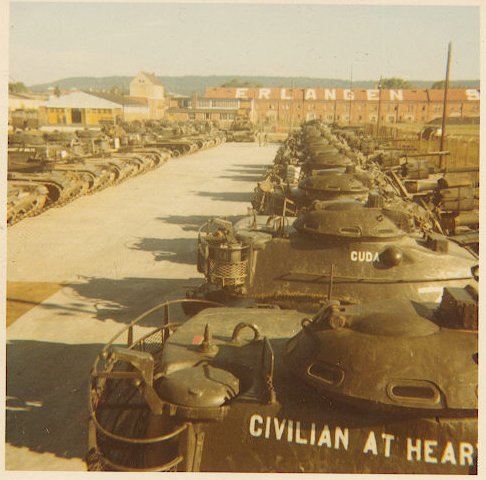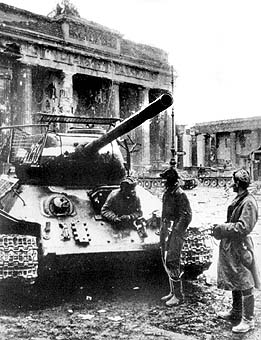Of the two basic types of Armor, which might be considered better overall? Hot rolled case hardened armor, or, Cast homogenous armor. They both have desirable qualities, how would you rate them?
The rolled homogenous armor is the better, it have superior mechanical qualities than the cast armor. The cast is faster to produde however.

Agreed meine freunde, it was very tough to penetrate, being that it was hardened, and the type of steel was also important to its success. I had heard that warships were protected by an armor made of “Wooten” steel, I am thinking that was "Wootz"steel, an ultra high carbon steel that was nearly indestructible, and is what true “Damascus” steel is composed of.
The cast armor, aside from being easier to produce, and use in tank production, was not as likely to “spall”. and splinter if it was penetrated, or struck by a squash head shell. The rolled, hardened armor did splinter alot more, but was less likely to be penetrated to begin with. The U.S. tanks of the 60’s and 70’s well, until the Chobham armor appeared were made of cast 4140 steel, (Moly, or Chrome moly) that was to allow a round to move through the armor with the least amount of seconadary projectile damage. (I personally prefer it didnt get through at all, but I guess i’m fussy,)

Incidentally the cast steel armor have a more rough surface wich is more likely to “grab” the armor pierging capped proyectiles.

You are correct sir! Ballistic traps are a real problem with cast armor, when I was a tank Commander in the 70’s, we didnt like the rough armor either. The Army people said that it didnt really matter, as the ammunition technology nullified the ballistic trap situation. Basically they meant that since you will be hit by shape charge Heat rounds, or Carbide arrow shells, it wont matter what the armor is like. You are going to be holed. we didnt see the humor in it.
You are correct, but I was thinking in ww2 tanks and tanks ammo characteristics.
Agreed my freind, I was just relating a personal anecdote supporting your earlier posting.I have always been a fan of metalurgical technology, and so this is an interesting topic for me. The armor produced by German industry in those days was a marvel of its time. Especially considering how recent a development it is(in a historical sense) the ability for man to produce large quantities of steel, much less tool steel, and high carbon steel alloys . The German hot rolled armor is kind of the Holy Grail of metal arts.
- Raspenau -
The armor german armor have some lack of nickel in 1944 to the end of the war but they compensated that increasing the level of manganese and Carbon steel.
Probably the best technological advance was the intensive use of arc electric welding even in 100 mm thick plates.

The use of Manganese in a higher carbon steel adds huge amounts of toughness to the finished alloy. Its the best additive to use, when toughness, abrasion resistance, and strength are paramount qualities. You have a good head on your shoulders Panzerknacker.
The only disadvantage of this tipe of alloy is that it teorically gave some “britleness” to the steel plate. According to russian sources the tankers wich used captured Pz V Panthers in 1944-45 reported some spalling of the back side of armor after being hit.
I saw not any report of that from th german side but is no doubt that this would be a less elastic steel. However considering the thickness of the plates used in the latest german AFV like Tiger , Jagdtiger and Jagdpanther the effect seems to be minimizated simply ading more armor.

You have a good head on your shoulders Panzerknacker
Thanks but I already know that  .
.
And a picture to demostrate my statement above.

That is one nice pic ! Rolled armor does have the habit of spalling and splintering more than the cast, even if its not hardened, perhaps the plates’ surface becomes work hardened during the rolling process. the boundary between the harder surface, and softer inner metal would be very thin, and that could account for the problem. Hardened plates would also have this boundary, a transition between higher and lower energy states within the plate. Though this would be wider, and maybe more diffuse.
The grain structure of a rolled plate is like floor boards, interleaved, and stacked tightly, this is due to compression of the grains by the rolling machine. The cast armor has natural grain shapes, more like a tile floor. and with a casting, the carbides of iron and other precipitates migrate to the edges of the grains, and create a weak cohesion between the grains.In a rolled, or hammered plate, These precipitates are broken up, and re-distributed into the metal when it is rolled.
Seems that you are in the metal bussines  , nice explained, In the case of the late war german rolled plate I would said that most of the brittlenes was caused by the large amout of carbon, extremely hard but not so “viscous” as other rolled plates used in American, british vehicles.
, nice explained, In the case of the late war german rolled plate I would said that most of the brittlenes was caused by the large amout of carbon, extremely hard but not so “viscous” as other rolled plates used in American, british vehicles.
I my opinion the best cast armor in ww2 was the russian from 1943 to the 1945, it had a very high content of chromiun, nickel, moly and even small amounts of tugsten and according to several pictures seems not so vulnerable to “craking” as western allies cast armor.
And what about spaced armor?
schurzen in a Pz IV:

You mean spaced armor as in the add ons?
I think it nice protection…just a little something extra. Can rebound anti-armor rounds (ie: Personnel Armor Peircing Rifle)
Yeap, I mean that, the spaced german armor what created to slow dow russian 14,5mm AT rifle bullets, without those protectionthe 14,5 mm AP could penetrate the sides of the pz III and IV shooting at close range.
Incidentally was also useful agaist hand trown shaped charges and bazooka because it make a early detonation of the warhead.
Add on armor, and standoff armor do pretty much the same job,with add-on armor, an incoming round must break the surface, penetrate the armor, which uses up lots of kinetic energy,while also placing huge strain on the shot or shell passing thru it. after going thru all of that bother, it then has to repeat the process with each succeeding layer. (layers are better. )Standoff armor also adds protection from squash head shells, by interrupting the shockwave of the explosive, preventing it from causing the dreaded spall on the interior of the tank.
Shape charges depend on proper timing of the initiation of the charge. it takes time for the jet stream to form, and focus, and its useful life is just milleseconds in length.This is the forte of standoff armor. Some standoffs cause premature initiation, too far from the armor surface to still be focused, and fully saturated to be at full potency. Other types work by deforming the shape of the copper cone in the warhead,or breaking up the explosive charge, preventing the formation of a coherent jet stream, defeating the weapon, or at least severely limiting its effects. Add-on armor has little ability to defeat shaped charges, (well modern ones anyway,)this does not however include the side skirt armor used on many tanks of WWII.
- Raspenau -
A animated gif to illustrate how the hollow charge works.

And its effect of 100 mm thick armor

That is impressive, did the jet stream exit the opposite side of the vehicle? The Shaped charge round was the great equalizer among tanks, no more need for extreme velocities, or smart gunnery, just touch the enemy, and poof! up he goes. I think this one development changed the way in which tanks were to be deployed. Jumping into the future a moment, In the 70’s we had 2 basic anti tank rounds in our basic load. the APDS carbide sub caliber high velocity penetrator, 5,000 ft/sec. and the H.E.A.T. shaped charge fin stabilized round. Both eminently capable choices, so no other types of A.T. round remained, just those two. We also loaded a Squash head type round for soft targets, and Flechette rounds for lightskin/ anti personnel use. Okay, forward into the past again.
The shaped charge was first discovered by an ordnance inspector named Monroe around 1896. he observed that blocks of guncotton would cut images of the “U.S.” marking pressed into the sides of the blocks, into the steel plates that held them for testing.(Later called the “Monroe effect”) at some point someone figured this could be developed into a potentially useful weapon, and the principle was tried on many different sorts of weapons. and gives us what we have today. - Raspenau -
That is impressive, did the jet stream exit the opposite side of the vehicle?
Yes, note tha is this case the melted metal jet had divided in two, look at the small orifice above the bigger one.
The shaped charge was first discovered by an ordnance inspector named Monroe around 1896. he observed that blocks of guncotton would cut images of the “U.S.” marking pressed into the sides of the blocks, into the steel plates that held them for testing.(Later called the “Monroe effect”) at some point someone figured this could be developed into a potentially useful weapon, and the principle was tried on many different sorts of weapons. and gives us what we have today. - Raspenau
That is correct, the first military use of the Monroe effect was the german paratroopers in 1940 blasting some heavily armored gun turrets in the Belgian Fortress Ebel Emael.
Effect of the 50 kg hollow charge:


The only defense in ww2 against this was to disrupt the effective HEAT charge distance of work by means of spaced armor or other cheaper devices like wire mesh.
T-34 with “antipanzerfaust” screens.

Multiple perforations are not uncommon with these weapons, (the more the merrier on thinner armor,) I am amazed at the damage these things can cause in even very thick armor. or oblique strikes, into the length of a plate rather than across it. I have seen penetrations of more than 15" nearly 400mm before the stream blew through the side of a plate or casting. (but this is with newer weapons. ) modern weapons incorporate an standard explosive to remove any stand off armor, or screens before the shaped part does its job.(somewhat unsporting I think,) - Raspenau -
